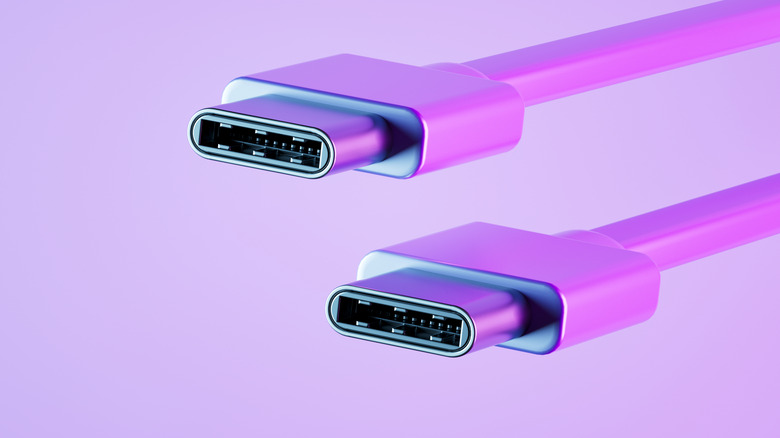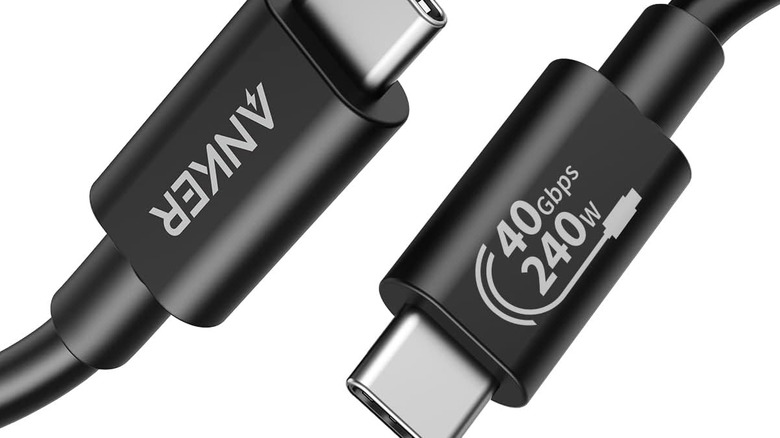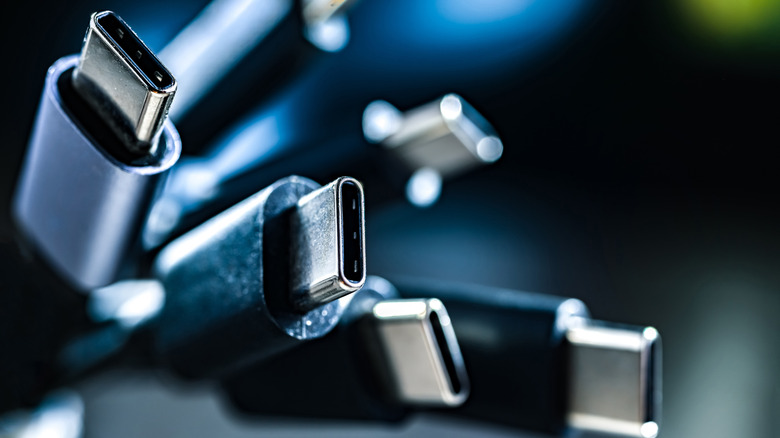Are All USB-C Cables The Same? What You Need To Know Before You Buy
We may receive a commission on purchases made from links.
The introduction of USB Type-C in 2014 was a welcome change for consumer technology. Users had grown frustrated with the confusing mess of different USB standards proliferating across devices. Computers were likely to use a rectangular Type-A port, printers a pinched-square Type-B, and mobile devices got either Mini or Micro USB. By being small enough to fit on any device and powerful enough to replace all of those standards, USB-C heralded a world where you could plug any cable into any port and things would simply work. It was even reversible, which meant no more squinting at ports to figure out which side of the USB connector faces up.
Unfortunately, that utopia never arrived. Today, things are almost more confusing than they used to be. Although USB-C is capable of handling the fastest USB port types, transmitting data, audio, video, and power, it's not mandatory for cable manufacturers to include all of those functions. Meanwhile, as new versions of USB are released, the problem compounds. Although some cables list their capabilities, others have no such markings. This makes it nearly impossible to tell the difference between a cable that works with the fastest type of USB port and one that does not.
Your best option is to make sure you know what you need from a USB-C cable before you shop for one, then choose accordingly. That means understanding not just what USB-C can do, but also what your devices are capable of.
USB-C cables look the same but have different capabilities, so shop carefully
In general, USB-C cables tend to transmit data to move files and power to charge devices. Some USB-C cables are also able to carry audiovisual signals, meaning they can be used like HDMI or DisplayPort cables. Capabilities vary, and some cables support faster charging or data transfer than others.
USB-C can transmit data at up to 80 gigabits per second (Gbps) with the latest USB4 Version 2.0. Some ports or cables will use much slower speeds, all the way down to 480 megabits per second (Mbps) for those using the older USB 2.0 standard. As for charging, some cables can now deliver up to 240 watts of power, which is enough to charge many laptops. On the low end, you'll find them capped at 60W — still sufficient for most smartphones. The most budget-oriented cables deliver as little as 15-18W at 5V/3A.
For video, you'll need a cable with Alt Mode HDMI or DisplayPort, which will allow you to hook a USB-C device up to a TV, monitor, or projector. You may still need a dongle, since the average TV or monitor is unlikely to have a USB-C port that supports video input.
When shopping for a USB-C cable, choose based on the limitations of the devices you plan to use it with. If you need a cable primarily for charging, prioritize its rated wattage, but if you need it for moving files across devices, prioritize data transfer ratings. If you're looking to future-proof your tech, it's worth opting for a cable with the latest USB4 specifications, but those are generally much more expensive.
How to tell USB-C cables apart
If you've already got a bunch of USB-C cables sitting around, you've probably lost track of which ones do what. And if you're shopping for new cables, differentiating them from the start can be tricky. There's only one surefire way to know a USB-C cable's exact specifications, and that's to check the product packaging or the online listing. A cable's data transfer and power delivery speeds will almost always be listed, along with whether or not it supports Alt Modes for video out.
If you're looking at an unpackaged cable, check for official USB-IF branding. Newer cables that are USB-IF certified will have their data and charging specs printed on the plastic head that the connector itself sticks out of. The branding will say, "Certified USB," alongside the relevant numbers. Cables from before this branding was introduced may instead use the SS USB logo to indicate SuperSpeed. You should also be aware of Thunderbolt cables, which are USB-C cables that use proprietary tech from Intel. You can read up on those in our Thunderbolt 5 explainer.
Many cables are unfortunately unmarked, but here's a clever trick. Each generation of USB cable has a maximum allowed length. USB 2.0 cables can be up to 16.4 feet long, USB 3.0 and 3.1 top out at 9.8 feet, and from USB 3.2 up to USB4, the limit is 2.6 feet. This won't help you determine a USB-C cable's exact specs, but it will rule things out. If you're looking at a six-foot cable, you automatically know it uses USB 3.1 or earlier.


